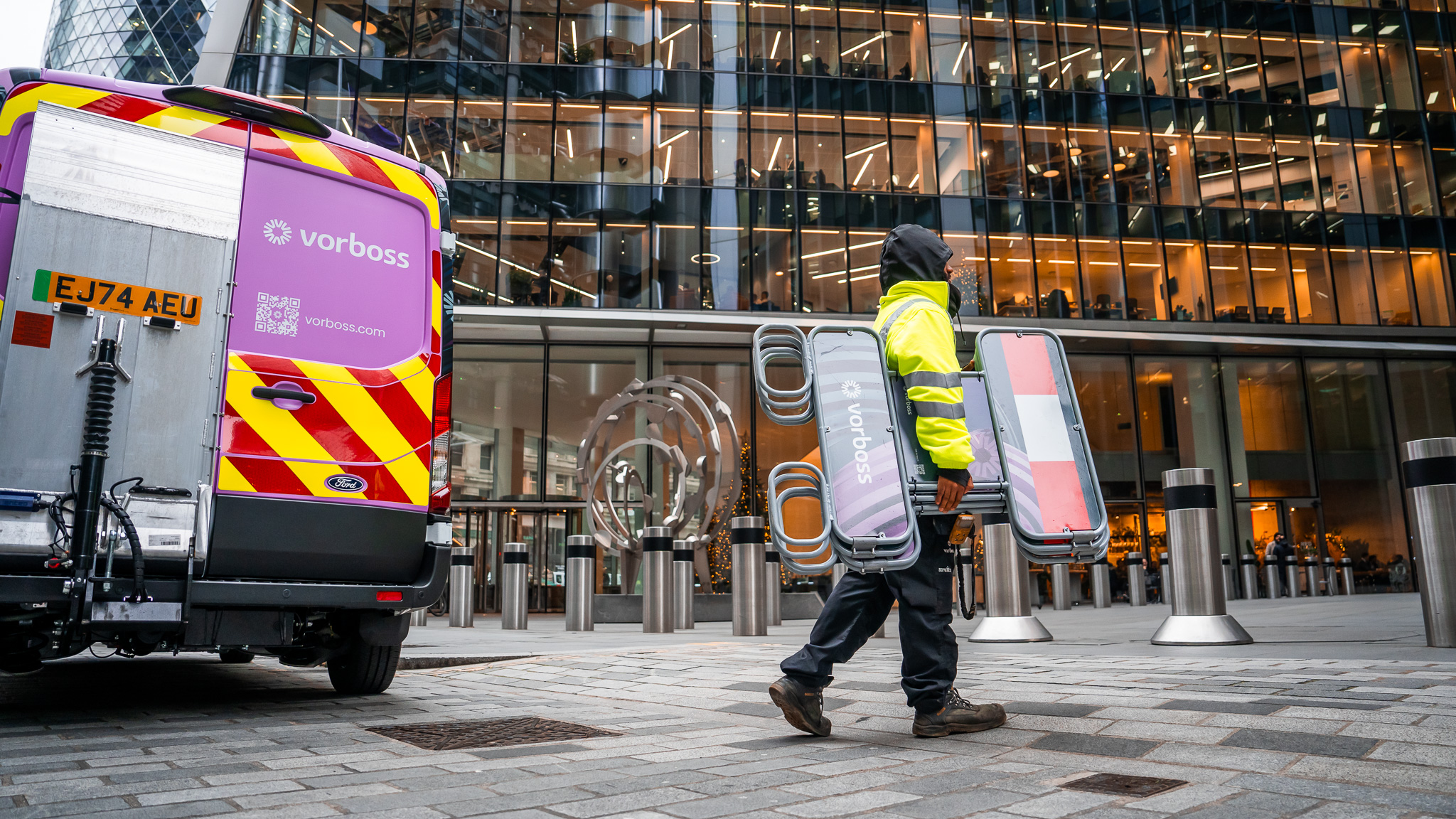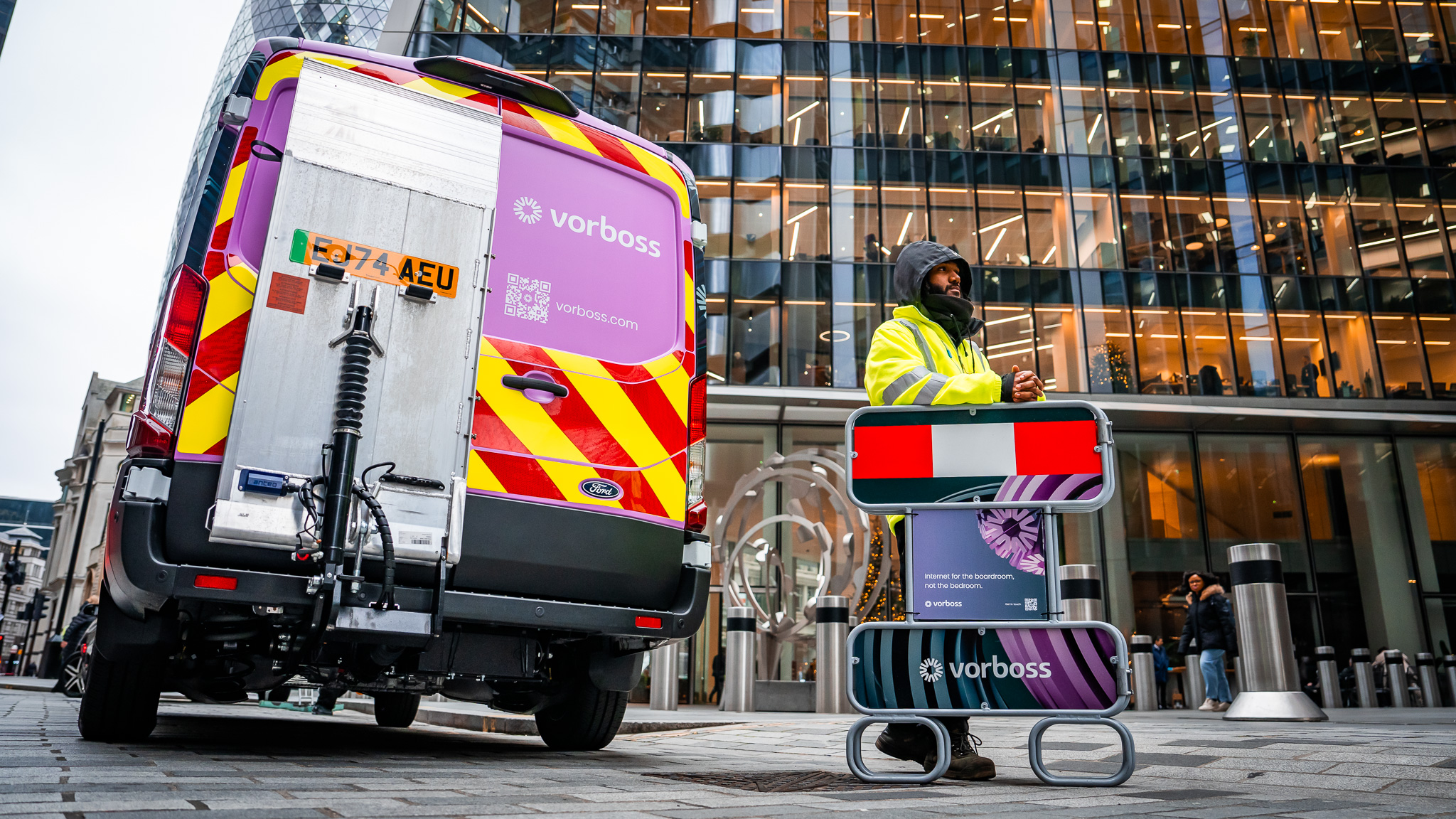-min.jpg)
Highlights
Plan your office move with confidence! Our complete guide covers timelines, trends, budgeting, IT setup, and connectivity tips to ensure a smooth, stress-free relocation for your business.
Moving office is a big deal for any business. That’s why knowing what you need to consider is vital in ensuring it goes smoothly and successfully.
So, whether you're upsizing, relocating to a more convenient spot, or upgrading to a more modern environment to encourage people back to the office, it's a moment that requires careful planning.
So, we’ve put together this guide to help you stay on top of everything – from planning and budgeting to keeping your team connected and productive from day one.
Why read this guide?
Even if you've planned an office move before, the London commercial property market is ever evolving. For instance, the demand for flexible workspaces has surged, with a 14% year-over-year increase in inquiries for flexible office spaces in the first half of 2024. Understanding these trends can help you make informed decisions that align with your business objectives.
Vorboss has been involved in hundreds of office moves, helping businesses sidestep connectivity delays and operational headaches. We know what works, and we’re here to help you make informed decisions for a stress-free move.

London's office relocation landscape
London’s office market has proven to be incredibly resilient. In 2024, the Central London office leasing market recorded a total take-up of 9.68 million sq ft – a 1% increase from the previous year. A key driver? Businesses seeking high-quality, flexible spaces that fit their evolving working models.
The demand for flexible workspaces is particularly strong, with occupancy rates climbing to 83% on average in early 2024 – and as high as 88% in key areas like Southwark and the City. If you’re considering a flexible lease, getting ahead of the curve is essential.

Things to consider when moving office
Planning an office move isn’t just a logistical challenge, it’s a strategic initiative that can significantly impact your business. Here are some of the reasons why planning an office move with real care is essential.
Ensuring a smooth process
A well-planned move means fewer headaches, from packing up years of accumulated ‘stuff’, to setting up your new space. Breaking it into clear stages with assigned responsibilities ensures everything runs on time and on budget.
Avoiding unecessary costs
Office relocations can get expensive. A detailed budget from the outset that includes all anticipated expenses - moving services, IT setup, rent, service charges, utilities and office redesign - reduces the risk of overspending.
Meeting lease obligations & avoiding legal issues
Moving out isn’t just about handing back the keys - you must meet your landlord’s requirements, including cleaning, repairs, and restoring the space. Be mindful of hidden costs such as dilapidation clauses, which may require restoring the space to its original condition upon lease termination. Factor this in early to avoid surprises.
Negotiating lease flexibility
In an evolving market, flexible lease terms can provide the agility to adapt to changing business needs. Consider options that allow for scalability or early termination without significant penalties.
Minimising downtime
Business continuity is critical, and even a day of disruption can impact your bottom line. A well-thought-out plan ensures your operations continue with minimal interruptions. For example, respecifying and pre-installing IT and connectivity in your new office allows your team to hit the ground running on day one.
Collaborating effectively with stakeholders
Moving office involves input from multiple stakeholders; colleagues, service providers, and landlords. Open communication and regular updates ensure everyone is on the same page, reducing the likelihood of misunderstandings or last-minute surprises.
Creating a positive experience for your team
A well-planned office move shows your commitment to employee comfort and productivity.
Proper planning for your office relocation is about more than logistics; it’s about safeguarding your operations and setting the stage for growth. By taking a strategic approach, you can turn the challenge of moving into an opportunity to enhance your business.
How to prepare for moving office

Successful moves hinge on clear communication, precise planning, and a proactive approach to problem-solving. Here’s how to prepare for an office move with ease:
Set your timeline
When you’re planning an office move, determine your moving date and work backwards from there to create a detailed schedule of tasks. Ensure you allow sufficient time for preparation, including securing service providers, notifying stakeholders, and completing physical packing.
Assess your space requirements
Evaluate your current and future needs, considering team size, growth projections, and the nature of your operations.
Put together a ‘moving team’
Assign specific responsibilities to a dedicated team of your own people or hire a professional relocation company. Allocating clear roles ensures accountability and streamlines decision-making.
Audit your current space
Conduct a thorough assessment of your existing office. Sort through equipment, furniture, and files – decide what to move, sell of recycle.
Plan your new layout
Work with a space designer or team member to develop the floor plan for the new office. Think about workflow optimisation, employee comfort, and what you might need in the future to deal with expansion. Oh! And don’t forget essential areas like meeting rooms, breakout spaces, and places to accommodate IT infrastructure.
Prioritise IT & connectivity
This is where we see the biggest mistakes! Vorboss has helped numerous companies recover from underestimating connectivity lead times. Start early to ensure your new office has the right internet speed, bandwidth, and security from day one. But, if you have left it a bit late, we do have a Rapid Install service, which you can find here.
Give everyone warning
Tell all your clients, suppliers, and service providers that you are moving office ahead of time. Provide them with clear timelines and your new address to avoid interruptions. Update your website and social media with the new address.
Schedule utilities and services
Confirm the installation of all the key utilities such as electricity, water, and internet well before moving day. Choose suppliers that you can trust, and understand your office move requirements – there's often more choice than you think.
A timeline of everything you need to think about when moving office
Knowing how to timeline an office move can be daunting, but by anticipating potential challenges and allowing room for unexpected setbacks, you’ll ensure a smoother transition.
To help with this, we’ve blocked out a typical move timeline:
6-12 months before the move
Define your needs
Identify the reasons for the move and create a list of must-haves for the new space. Think about size, future growth, location, and required facilities to ensure the new office will meet your business needs.
Secure your new location
The demand for flexible office space in London has increased, with occupancy reaching 83% on average. If you’re considering a flexible lease, start early to secure the best options.
Establish a budget
Develop a comprehensive budget for the office relocation. Include contingency funds to cover unexpected expenses.
3-6 months before the move
Get your suppliers sorted
Surround yourself with pros. Hire professional movers, fit-out companies (if needed), and IT specialists to ensure your relocation goes smoothly. Book them in early to avoid last-minute scrambling.
Plan your connectivity
Work closely with a good business internet provider to ensure seamless service. This step is critical for maintaining business continuity and productivity from day one.
Notify your team
Keep everyone in your company informed about the move and provide them with regular updates. Share a timeline and what to expect during the transition.
1-3 months before the move
Begin packing
If doing it yourself, organise your packing process systematically. Label boxes clearly with their contents and their destination within the new space.
Update addresses
Notify your clients, suppliers, and service providers of your change of address. Prepare to update your business listings, website, and marketing materials.
Test IT systems
Arrange for your IT and connectivity systems to be tested rigorously before moving across. This way, you can be sure that critical services such as the internet and phones are operational before your team arrives. Any good connectivity supplier should offer to connect your office ahead of your move-in date to ensure a smooth transition, wavering the cost of any cross-over to avoid being double-charged.
Moving day
Oversee the process
Assign a trusted team member (even if that is yourself) to supervise the move. Choose someone who can handle unexpected issues and ensure that everything arrives at, is installed into, and functions properly in the new location as planned.
Prioritise essential systems
Prioritise real-world troubleshooting of IT infrastructure, connectivity, and other essential services on the day. This guarantees that your team will be able to resume work efficiently, no matter what.
Post-move
Do a walkthrough
However thoroughly you planned your office move, once you are in you need to inspect the new space carefully to ensure everything is in order. Check for damage, missing items, and other issues that need immediate attention.
Celebrate with your team
Planning an office move and continuing to function as a business while the relocation is underway, are great achievements. So, be sure to acknowledge the hard work all round that’s gone into the move and celebrate - you’ve earned it!
By following this timeline, you’ll have the basis for your own step-by-step approach to managing and planning your office move efficiently. Working through these stages will enable you to reduce stress (both for yourself and your colleagues) and set the business up for a flying start in its new home.
What to look for in a business internet supplier when moving office
Moving office is stressful enough without getting stuck in a bad internet contract. Unfortunately, we speak to too many businesses who only realise the fine print has tripped them up when it’s too late. Before you sign anything, here are five things to check:
Mid-contract price increases
Some providers sneak in clauses that let them hike your prices during your contract. That means you could sign up at one price and end up paying much more down the line. If your business needs cost certainty (who’s doesn’t?), ensure you’re locked into a fair price for the whole term.
Auto-renewals
Not all contracts end when you expect them to. Some providers auto-renew you into another long-term deal without much warning, making it hard to leave when you need to. Check the small print and set a reminder well before your contract is up.
Service guarantees vs. empty promises
Your provider might say you’ll get ‘up to’ a certain speed, but is that guaranteed or just a target? If a stable connection is critical for your business, look for providers that commit to actual performance, not just marketing buzzwords. If you’re buying a broadband grade service, your speeds are almost definitely not guaranteed so make sure your connection is dedicated to your business, find out more about that here.
Compensation without the hassle
If your internet goes down, will your provider compensate you automatically, or will you have to fight for it? Some suppliers make you jump through hoops to claim what you’re owed, knowing most businesses won’t have the time. A good provider makes things right without the headache.
Do they own their network?
Moving office comes with enough deadlines - your internet install shouldn’t be another thing keeping you up at night. Check if your provider owns and controls its own network or if they’re relying on third-party contractors for installation. If they don’t have full control, delays can stack up, leaving you without internet when you need it most.
Bottom line? Don’t just sign what’s put in front of you. Ask questions, push for clarity, and make sure your internet service works for your business - not the other way around.
2025 Commercial real estate trends to think about
An increased demand for sustainable, premium offices

Market consolidations

Hybrid working
.avif)
How Vorboss can make switching internet as easy as possible when moving office
Moving office gives you the ideal opportunity to reconsider your connectivity needs - especially if part of your move is to support company expansion. While switching internet service provider (ISP) during an office relocation might seem like a daunting task, we have a whole host of solutions to help support your move – even if you’re on a tight deadline:
Expert support every step of the way
Vorboss provides dedicated support throughout the relocation process, from initial planning and infrastructure assessment to post-move optimisation. Your dedicated, London-based account manager will help you address any challenges and ensure your internet service aligns perfectly with your business requirements.
The Rapid Install advantage
Vorboss’s Rapid Install service is a game-changer if you’re looking to minimise downtime as you prepare for an office move. We designed this service to provide high-speed internet installation on a tight timeline, so you can be certain your new office will be fully operational from the moment your team walks through the door. Unlike others, we’ll work to your timeline.
Dedicated fibre connectivity
So, you’ll never have to worry about connectivity again. Unlike broadband, which is split among multiple users, Vorboss provides each business with its own fibre line. We built the network from the ground up with our own teams, which means we can ensure the quality and reliability of your connectivity.
Switching internet services doesn’t have to be a headache. Get access to tailored connectivity solutions, expert support, and industry-leading reliability. Let’s chat!
Tell us about yourself so we can serve you best.
Got a question?
More articles

For many landlords and building managers, the word “wayleave” feels like the responsible route whenever a fibre circuit is being installed on their property. It sounds formal and safe – a neat legal box to tick.
In many cases, however, a wayleave adds unnecessary complexity and delays, frustrates tenants, and can expose landlords to long-term legal risks.
At Vorboss, we’ve connected thousands of office spaces across London without a wayleave, keeping landlords in full control and getting tenants online faster.

What is a wayleave?
A wayleave is a written agreement between a landowner and a telecoms operator. It gives the operator permission to install and keep equipment on private property.
What many people don’t realise is that signing a wayleave also activates “Code rights” under the Electronic Communications Code. These rights go beyond simple permission, they give the operator legal powers to stay on the property indefinitely, access it when needed, and even refuse removal of their equipment in certain situations.
For a typical connection into a commercial building in London, a wayleave can make the fibre installation process slower, more expensive, and limit the landlord’s flexibility long term.
Why a wayleave isn’t required for standard in-building fibre connections
For a standard in-building fibre connection serving a tenant, a wayleave isn’t a legal requirement. Important protections, like building access, fire safety, repairing any damage, and removing equipment, are already covered by the tenant’s lease and usual building rules.
If no wayleave is signed, no Code rights are triggered, meaning the landlord retains full control and the installation exists under a simple, fully revocable licence.
In practice, this gives landlords far more protection and flexibility:
- No legal lock-in – the telecoms operator has no long-term rights to stay or refuse removal.
- Landlords keep full control – equipment can be moved or removed when the building changes.
- Faster fibre installation – no time lost in drafting contracts or solicitor reviews.
- Happier tenants – connections go live quicker; tenants get to move in faster.
By contrast, signing a wayleave and granting Code rights introduces a complex and expensive legal process for any fibre removal or relocation. This can take at least 18 months, plus potential court or tribunal proceedings, making it slower, and far less flexible for the landlord.

Public services across central London are evolving, and the City of London Corporation is leading the way.
Whether you work, live or study in the Square Mile, you’ll soon feel the difference that faster, more dependable connectivity brings.

What is the Future Network Programme?
The City of London Corporation is rolling out the Future Network Programme, a major project to modernise its entire digital infrastructure and bring everything under one unified network.
From offices and schools to iconic green spaces like Hampstead Heath, cultural destinations like the Barbican, and historic markets such as Leadenhall and Old Spitalfields, this upgrade will mean more reliable connectivity across the City’s buildings and public spaces.
It also extends to essential services, including critical sites run by the City of London Police. This enhanced connectivity will support everything from secure communication systems to faster, more resilient networks for emergency operations.
Leading this transformation is Roc Technologies, supported by Juniper Networks and Palo Alto Networks; all powered by the Vorboss fibre network. Together, we’re bringing the City onto a modern digital foundation that’s ready to support its future.
Who the Future Network Programme benefits and how?
The programme is designed for everyone who depends on public services in the Square Mile:
- Students in City-run schools will have fast, reliable connectivity to fully access digital learning tools.
- Public-sector teams will experience smoother hybrid working, better access to online platforms, and more efficient collaboration across locations.
- Residents and visitors will see improvements in public Wi-Fi, digital services, and online access in libraries, community hubs, and other shared spaces.
- The City of London Police will gain a more secure, faster and resilient network that enhances CCTV reliability and enables more effective frontline operations.

.avif)

.avif)

